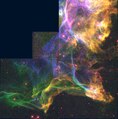File:The Cygnus Loop Nebula- Shockwave from a Stellar Explosion (1995-11-272).jpg

Original file (1,506 × 1,525 pixels, file size: 537 KB, MIME type: image/jpeg)
Captions
Captions
Summary
[edit]| DescriptionThe Cygnus Loop Nebula- Shockwave from a Stellar Explosion (1995-11-272).jpg |
English: This image shows a small portion of a nebula called the "Cygnus Loop." Covering a region on the sky six times the diameter of the full Moon, the Cygnus Loop is actually the expanding blastwave from a stellar cataclysm - a supernova explosion - which occurred about 15,000 years ago. In this image the supernova blast wave, which is moving from left to right across the field of view, has recently hit a cloud of denser than average interstellar gas. This collision drives shock waves into the cloud that heats interstellar gas, causing it to glow. Just as the microscope revolutionized the study of the human body by revealing the workings of cells, the Hubble Space Telescope is offering astronomers an unprecedented look at fine structure within these shock fronts. Astronomers have been performing calculations of what should go on behind shock fronts for about the last 20 years, but detailed observations have not been possible until Hubble. This image was taken with Hubble's Wide Field and Planetary Camera 2 (WFPC2). The color is produced by composite of three different images. Blue shows emission from "doubly ionized" oxygen atoms (atoms that have had two electrons stripped away) produced by the heat behind the shock front. Red shows light given off by "singly ionized" sulfur atoms (sulfur atoms that are missing a single electron). This sulfur emission arises well behind the shock front, in gas that has had a chance to cool since the passage of the shock. Green shows light emitted by hydrogen atoms. Much of the hydrogen emission comes from an extremely thin zone (only several times the distance between the Sun and Earth) immediately behind the shock front itself. These thin regions appear as sharp, green, filaments in the image. This supernova remnant lies 2,500 light-years away in the constellation Cygnus the Swan. |
| Date | 20 February 1995 (upload date) |
| Source | The Cygnus Loop Nebula: Shockwave from a Stellar Explosion |
| Author | Credit: Jeff Hester (Arizona State University) and NASA |
| Other versions |
|
| Keywords InfoField | Emission Nebulas; Supernovae; Stars; Nebulas; Supernova Remnants |
Licensing
[edit]| Public domainPublic domainfalsefalse |
This file is in the public domain because it was created by NASA and ESA. NASA Hubble material (and ESA Hubble material prior to 2009) is copyright-free and may be freely used as in the public domain without fee, on the condition that only NASA, STScI, and/or ESA is credited as the source of the material. This license does not apply if ESA material created after 2008 or source material from other organizations is in use.
The material was created for NASA by Space Telescope Science Institute under Contract NAS5-26555, or for ESA by the Hubble European Space Agency Information Centre. Copyright statement at hubblesite.org or 2008 copyright statement at spacetelescope.org. For material created by the European Space Agency on the spacetelescope.org site since 2009, use the {{ESA-Hubble}} tag. |
File history
Click on a date/time to view the file as it appeared at that time.
| Date/Time | Thumbnail | Dimensions | User | Comment | |
|---|---|---|---|---|---|
| current | 21:32, 7 March 2024 |  | 1,506 × 1,525 (537 KB) | OptimusPrimeBot (talk | contribs) | #Spacemedia - Upload of https://stsci-opo.org/STScI-01EVTAVWPDZVTNZVKB9GJBW5NV.jpg via Commons:Spacemedia |
You cannot overwrite this file.
File usage on Commons
The following 2 pages use this file:
Metadata
This file contains additional information such as Exif metadata which may have been added by the digital camera, scanner, or software program used to create or digitize it. If the file has been modified from its original state, some details such as the timestamp may not fully reflect those of the original file. The timestamp is only as accurate as the clock in the camera, and it may be completely wrong.
| Image title | Ghostscript 24 bit color image dump |
|---|---|
| JPEG file comment | Ghostscript 24 bit color image dump |
| IIM version | 2 |
